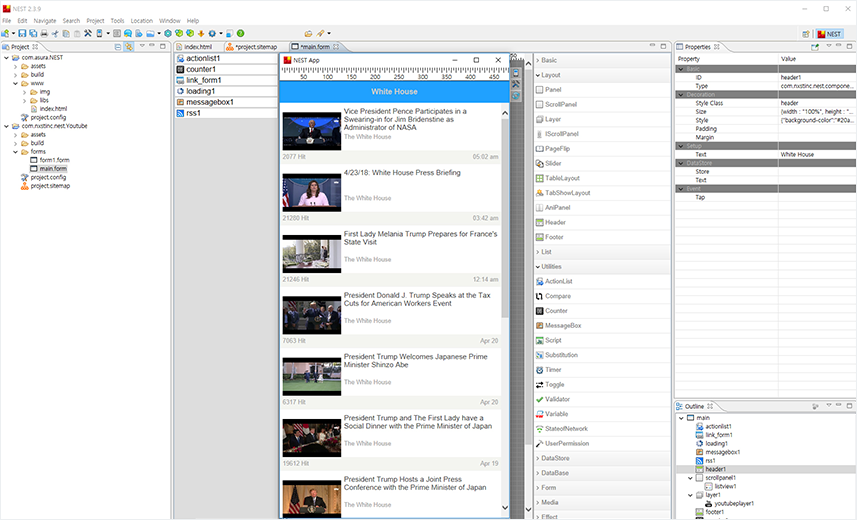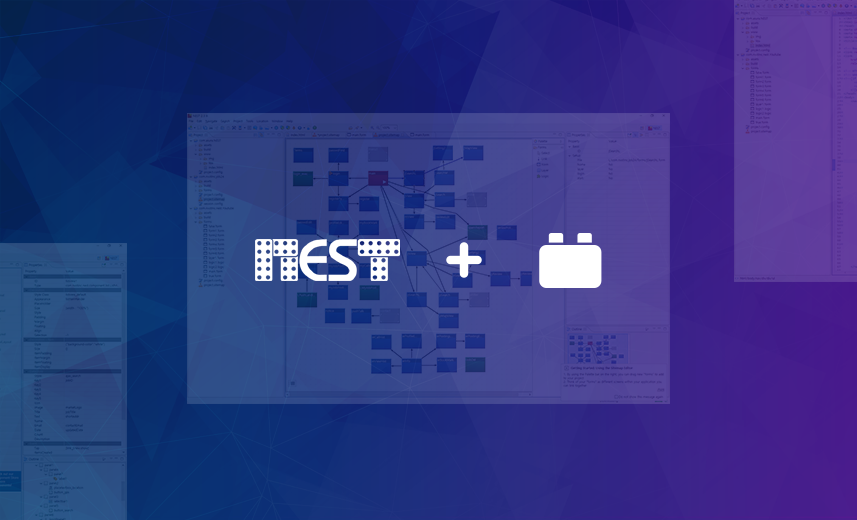
The NEST IDE framework is a 'COMPONENT BASED' development solution that allows users to publish mobile apps without any code. App development is done through the drag and drop mechanisms in the desktop UI which creates flexibility around the UX, UI, app events, and data interface. This an extremely scalable and effective way to consistently build high quality mobile applications.

Reinventing the process
Code optional
NEST users can develop an app either with or without code, or a mixture of both. Utilizing the code optional capability, the component based architecture was formed to break free form limiting templates and expedite creativity of development. For those with a software engineering background, NEST allows you to handle the app code behind the NEST components.
The Simplicity of One
The NEST platform covers the application development process flow from ideation, design, build to deploy. NEST is your one stop source to cover all aspects of mobile application development. It simple and easy to proceed to next step of application development with seamless develop-build-deploy-maintain user experience for developers.

Component based app development methodology
Seamless integration of external sources
NEST simplifies the compilation and implementation of resources through its Open Wrapping Interface. Resources such as the countless ISV published Open APIs, SDKs for application, and the expansive source library of experienced developers. Hence, all resocurces can be integrated into a NEST component. Once integrated into components they can then be utilized at anytime and as many times as needed.
Coninual Use and Monetize of App Resources
Use and reuse components whenever its needed, once its made or obtained from the component store it can be used at anytime for any future applications to come. Just like all other components on NEST, they can be utilized by simply selecting and placing where needed. Furthermore, newly added components can be monetized via NEST Component Store.

Tight binding with data & event flow
WorkFlow Editor
When an event occurs on the applications UI/UX an action is triggered. This action can be easily set, changed, or deleted through selecting and dragging the desired actions of the component onto the desired target. NEST application structure is composed of a completely divided UI, Logic and Controller, and Data process. It is also void of any inessential codes and a completely MVC pattern developed application. This feature makes it easy for users to understand the flow of applications, reducing maintenance cost and development time drastically.
DataFlow Editor
NEST provides RSS, JSON, XML, Database, Open APIs, etc. data components for the application Data Interface. The DataFlow Editor divides the data searching from what is displayed and internally processed. Connecting the properties of data processing components and data creating components can connect the entire Data Interface similar to the WorkFlow Editor.

Automated development configurations
NEST will simultaneously program code in both iOS and Android. NEST automates all the required user configurations including but not limited to :
automated OS platform and SDK download / patching, iOS Mobile provisioning profile management, simulation, iOS app store release formatting, Android configuration (automatic creation of android certification, Android app authentication, Android build, Android App Screenshot, App APK file installation management), and all functions needed to build and deploy apps for all OS platforms. Now you can simply build the app in NEST IDE and have the interface do that work simultaneous.

No coding for WAS & database connection
To address server and back end system needs, NEST users are able to develop server applications through the NEST WAS and NEST Database Connection Tool. The NEST WAS provides all functionalities of Mobile middleware system. With one click users can release the build and execution binary to the Host Server. Developer users can apply their own code to customize WAS to meet their needs. Also, there provide a Database Connection tool which enables users to complete Data Interface connections with only a mouse. Therefore, user developed RDBMS can also easily be loaded and connected onto NEST IDE. NEST users without any server knowledge can configure the server application they require.

80% of QA time cut
NEST significantly reduces 80% of QA time by providing an integraged simulator for all OS platforms. Furthermore, our Weinre debugger addresses any QA issues for web based apps. When the NEST users develop their apps, they are able to use a simulator all the time for testing iOS and Android apps simultaneosly.

Application Prototypeing
One major advantage to using the NEST platform is the ability to rapidly prototype your mobile app. Users can modify NEST provided sample applications to create a prototype of your application. Quickly stress test potential ideas and formulate next steps faster than the competition to give you the leading edge.
NEST App Workflow
Design

Scenario Design
NEST Project Sitemap provides a clear layout of forms and links that show relationships between forms. You can easily change the number of forms as well as adjust the order of forms by using link arrows.

User Experience Design
Properties Editor allow you to customize everything to your preference! You are not limited to already-made designs and templates. With live editing, you are able to see the design changes you make right away.

Logic Design
NEST Workflow separates layout and style logic. You can utilize NEST Workflow to set properties and assign events to each form. Also, NEST Data Binding helps you manage and process complex data and files visually.

Configuration
Configure your app visually using Project Configuration. You can set application images such as icons and splash images, device orientations, and themes.
Simulate

Simulate your app as you build.
There is no need to connect multiple devices to your computer to test your app. NEST Simulator is designed to let you preview your app regardless of which mobile OS you built it on. The best part is that this integrated Simulator is built in to the IDE and can be accessed easily.
See any errors?
NEST automatically detects all errors and bugs and displays them in NEST Warning and Error Detector. Let us help you find your errors and fix them. Cut down your development time, and make your app error free
Deploy

Deploy your app with NEST when you are ready.
Ready to launch your app on your phone or tablet? Choose a mobile OS-- Android or iOS-- and deploy it to your device. Your app will be up and running on your smartphone or tablet in just minutes!
Share your apps with everyone!
Upload your app to AppStore and Google Play to share your amazing apps with others.
NEST Components
Go to Component Store

NEST’s component based architecture built using the (exactly) CBD theory, enables its components to be ran and connected with each other within its container. Therefore, NEST components are truly the entities or building blocks that makeup its applications. Surprisingly, developing components on NEST is simple enough that even beginning developers will be able to comfortably create their components. Components created by NEST developer users are recompiled by NEST and loaded as components.
The components of NEST Platform are simple yet unique development resources. The application components are built with JavaScript, CSS, and HTML5 while the server components are built with Java. Components on NEST are 100% reusable and thus is able to reduce up to 70% of the application maintenance costs. Furthermore, creating new original components on NEST is effortless due to the powerful integration capabilities of the platform. Even new developers can create components by integrating open APIs and libraries onto NEST, and accumulate their own stored resources for development. External native source codes and libraries can all be integrated into NEST to create components with the same functions.
NEST components stand apart from other components in that even one instance or object can become a NEST component thus basic components such as a single line or message box can be created and used together to produce a variety of functions. NEST component development and its uses is elaborated in the Getting Started and NEST Developers Guide documents which can be found on both the NEST website and on the NEST IDE.

Component Interface and Property
While an application is running, components message other components and obtain information on its properties and connection method. Through this, applications consisting of different components are able to connect with each other without having to be specifically designed to do so. Components are able to display their properties openly so that they are able to efficiently connect with one another.

Parts warehouse
All parts needed to create an idea into a serviced mobile application on NEST can be found in the Component Store. User made components and NEST Team made components are both available here, in this application parts warehouse. The NEST Team will provide free components to promote growth of both the warehouse and user capability.